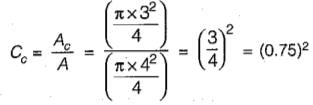Test: Energy Equation & Its Applications - 1 - Civil Engineering (CE) MCQ
10 Questions MCQ Test - Test: Energy Equation & Its Applications - 1
A Pitot-static tube, with a coefficient of velocity 0.98 is used to measure the velocity of water in a pipe. The stagnation pressure recorded is 3 m and the static pressure is 0.5 m. What is the velocity of flow?
The integral momentum equation requires the following assumption in the flow
| 1 Crore+ students have signed up on EduRev. Have you? Download the App |
A flow through an expanding tube at a constant rate is called
To avoid the tendency of separation of flow at the throat in a Venturimeter, the ratio of the diameter at the throat to the diameter of the pipe should be
A pipe of length more than double the diameter of the orifice fitted internally or externally to the orifice is called
A point in a compressible flow where the velocity of fluid is zero, is called
The equation P/w + V2/2g + Z = constant is based on the following assumptions regarding the flow of fluid:
A fluid jet discharging from a 4 cm diameter orifice has a diameter 3 cm at its vena contracta. If the coefficient of velocity is 0.98, the coefficient of discharge for the orifice will be
The coefficient of velocity for an orifice is given by (using usual notation)



















